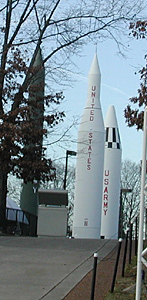
A few of the rockets at the entry to Rocket Park.
by carrie heeter
This page tries to convey a little of the flavor of Space Camp, captured during a visit to the Huntsville Alabama Space Camp headquarters by representatives from Michigan State University, ETI, and Apple Computer.
As we think about designing virtual experiences to extend the magic and inspiration of Space Camp over the Internet, a good place to start is to consider what makes Space Camp so engaging. Being there and participating in some missions really changed my understanding in ways that reading brochures and even touring the California Space Camp could not. Observing and participating are different. (brilliant insight, huh?)
The surroundings are thrilling. Driving to Space Camp, one sees what appear to be church spires but turn out to be rockets. Walking around, real space stuff is everywhere. Walking by and standing near shuttles and rockets bring home the shock of how big they are. Somehow the impact of their realism, outside in a park-like setting, is stronger than in a museum. Perhaps because things that big don't fit in museums. Perhaps because there are so many of them. Perhaps because the context of being a Space Camp participant for multiple days invokes a different relationship with the artifacts. I felt almost a sense of ownership or closeness to the space ships -- I've been on a mission in a space shuttle capsule like that one. And a stronger sense of reality. This is what space exploration is really like. I understand more, even if only a little more, about the how and why of design of the space ships.
The space stuff is serious but fun. (The front lobby has a giant high tech coke machine.) Paintings on the wall include photorealistic galaxies and science fiction art. Much of the equipment is real space stuff, but periodically one wears an imaginary space helmet to get safely through the airlock. A mix of make believe and real, imagination and rigorous science. The trees in Rocket Park have lots of model rockets hanging from them which got stuck there during rocket launching experiences. It's funny and awe-inspiring. You don't see a park full of enormous rockets very often.

A few of the rockets at the entry to Rocket Park.
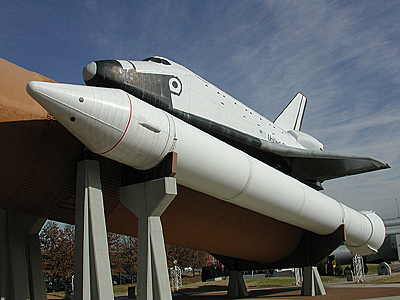
Shuttle (notice humans below for scale)

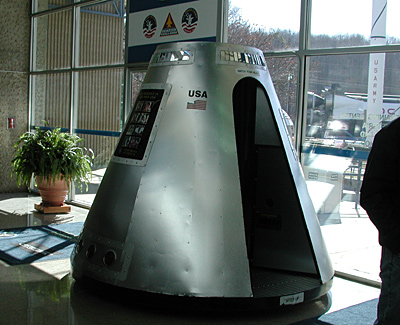
Every entry should have plants and a space capsule.
Our shuttle mission started out by donning flight suits. It's possible my love of Halloween makes this observation less than universal, but it made me laugh inside with joy every time I looked around at a room full of people in flight suits. I am extremely tempted to pay $75 to buy one and wear it every day as I work in my basement. Not high fashion, but so cool to be a part of the space program by wearing the uniform. Certainly the Space Camp fifth graders also feel some of the aura of the uniform, both on themselves and everyone else. Looking the part is a first step in the role playing to come. And it is part of the immersive experience of being there. In technologically mediated experiences we talk about avatars and representation of self. Our avatars should represent the child, and also should be costumed.
While we were there, a young child had convinced his mother to take him to Space Camp so he could donate his baby bottles to the space program. One of our group remarked he actually felt like an astronaut when they posed for a picture with the child and told him they would be going on their mission soon. When others treat you as an astronaut, you feel more like one.
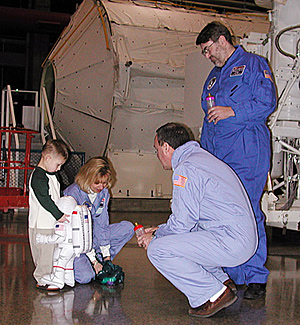
young future rocket scientist donates bottles to space program, poses with "astronauts"
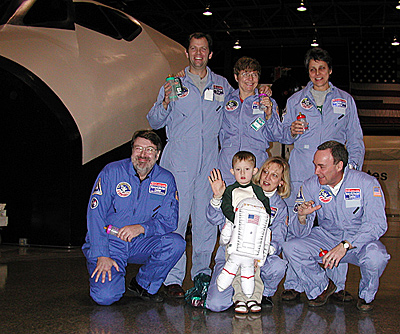
The rest of the content on this page is from the Space Shuttle 2 hour mission. Links at the bottom go to Mission to Mars video, photos, and commentary.
Simulated missions are a key part of the Space Camp experience. These missions are scripted, time-based, team role playing experiences paralleling the real thing. We started out in the Briefing Room.
We were given a four page list of Space Camp acronyms (EVA=extravehicular activity; LOX=liquid oxygen; MMU=manned maneuvering unit, etc.) A shared secret vocabulary contribes to formation of group identify and differentiation of group from everyone else. In this case, it is also the real language of space exploration. To me, this tie in to real, meaningful knowledge makes the learning much more appealing than a game for games sake. But then, I hate games. Our virtual experiences should build in and use space vocabulary.
Our program coordinator showed a professional, emotional music video of space program imagery and a song with inspirational lyrics about achievement and dreams. Space camp uses many of those. Watching it alone up close when I was relaxed would have had a stronger impact on me than in the midst of so many people and distracting real world possibilities. Perhaps because I am used to being alone in the basement all the time, so being with other physical humans is very distracting. The videos were awesome but they didn't touch me nearly so much as the rest of the experience.
She briefly described the goals of the mission, described team position titles and roles, and assigned people to positions. (My notes are imperfect but you get the idea.)
| MOCR (mission control) | (space) Station | Orbiter |
| FD/CAP (flight director-captain) | StatCom | CDR (commander) |
| EVA | POL | PLT (pilot) |
| PROPSHPI (booster propeller something) | FOL | MS-1 (mission specialist) |
| SSP (space station principle investigator) | SS | MS-2 |
| PS-1 (payload specialist) | ||
| PS-2 |
We then embarked for training, with the mission immanent. Being in the shuttle was amazing. With a team the approximate size of a real shuttle crew, you get a tangible sense of both how big the shuttle is outside, how much of that is for payload, and what a small space there is for 6 people to exist in for an extended period. Better than flying coach, but mighty intimate and confined.
Vivid imagery from the experience persist in my head. All of those rows of identical-looking numbered storage bins, each containing supplies or experiments, kept securely closed for when gravity goes away. Was the blood pressure monitor in MF28M or MF85G? (Why doesn't NASA put temporary meaningful labels on for each mission instead of requiring a lookup table!) The switches EVERYWHERE in the cockpit. How many times do switches get changed accidentally? Do they use these buttons so that the state of the button is observable? Many different people operate different buttons, so I guess a single computer could not replace the bizarre physical array of switches. Most switches have an observable state, but some do not.
Climbing up the runged steps into the cockpit -- hard to carry stuff. Health monitoring: it seems so crude to measure heart rate, lung capacity, blood pressure, and temperature. I could do that at home. The science and medicine of space is just like the science and medicine in a classroom or a laboratory. Many of the same tools and same processes. Tupperware. They keep the medical supplies in tupperware.
What's the point of these observations? They are part of my mental model of space exploration. I'll never read about or watch another shuttle launch without reliving those perceptions. They are physical, vivid perceptions. Not things I was told, but things I noticed. Different people surely came back with different prominent impressions. Please please please email me what you felt, and I will add your impressions to this page.
The training and the mission were stressful. I mentioned already the missions are time based. There is an overall mission script/timeline. Each team member's role has activities which have to happen at or before a specific time in the mission. Some of the roles have one or two notebooks with the script highlighting their role and times to act. Other positions share a timeline list on the wall.
Training goes fast, presents unfamiliar tasks, sometimes with explanation. I.e., take health measurements on the payload specialists before and after their EVA walk and report results to the commander. Makes sense, I understand what and why. Other times training gives instructions (flip switch DNF-A to ON, switch SDSS to 2, switch stsg to OFF, etc.) where you have no idea what you are doing or why. Steps are hard to remember from the quick run down. Press this button to depressurize the airlock. Wait until the indicator moves to the left side. Do something else I forget. Then it is safe for the payload specialists to enter the airlock and pressurize. If you forget and open the airlock at the wrong time, the entire crew will be killed instantly.
I tend not to learn or remember by listening -- would much rather have read a book about the mission the night before, and to have understood more about what the steps did. My fuzzy brain can't reconstruct the airlock stages. Space Camp has a program for children with disabilities called Space is Special. That program prepares kids for the space camp experience, providing background and training. Then the disabled kids join other kids at Space Camp and compete for quality of missions. The kids with disabilities usually win the competitions.
Teams members are interdependent. The mission specialists do physical health checks and open the airlock to let payload specialists in and out before turning to their science experiments. Commander and pilot launch the shuttle and take it into orbit. Timing and the script pull everyone into a shared experience. It's a lot like doing a reading of a movie script -- but adding in actual switches and controls, real science experiments and manipulations of satellite etc. Also, emergency deviations from the script are introduced unexpectedly at key moments by the Space Camp staff. The scripts are real. Real space talk, real launch steps. Video and readouts are synchronized to the simulation so there are external events, clocks, and displays in combination with humans following the script.
My first mission was traumatic. Many of the sequence of unfamiliar tasks need to be accomplished extremely quickly. We began by killing off the entire shuttle crew within our first 10 minutes due to incorrect airlock procedures. I felt terrible. Life went on. I carried the run down with me into the laboratory where we conducted experiments and I kept track of time. I mixed gross chemicals together to create a polymer which I think I stirred too much so the rest of the experiment didn't work. Cleaned up and advised my partner who was still experimenting we had plenty of time. Turned out I was reading the wrong side of the event list -- I was reading the two hour version and we were doing the half hour mission. So, we actually didn't have plenty of time. We were supposed to have returned to the main cabin 20 minutes a go. We didn't find out about this until the mission ended, with us still in the lab, not having performed any of our landing tasks. I felt like a complete idiot.
I am a professional behind the scenes person -- observer and organizer, not participant, by nature and by training. It was really important for me to experience the frustrating, timed nature of the mission. Colleagues reassured me they also felt stupid -- join the club, they said. Not a club I want to be a member of, I replied. Being challenged is an important part of the Space Camp mission experience. Failing some and succeeding some and sharing both experiences with your team is another key to the Space Camp experience. For our virtual experiences, I would prefer to allow the opportunity for more preparation. Perhaps we also want to offer observer/photographer kinds of roles for those who, like me, are not game-oriented.
I tried to back out of the second mission completely, but was thankfully offered a relatively un-involved position of monitoring the Space Station activities, sending faxes about unexpected disasters at timed moments in the script. This allowed me to shoot video and stills during the mission, which you can view below.
The Space Shuttle simulation video and photos appear below, followed by a link to the Mars Mission page.
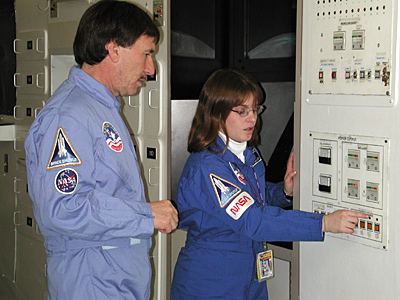
Space Station training before the mission
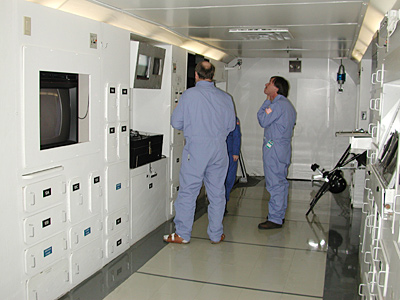

Science tools for space
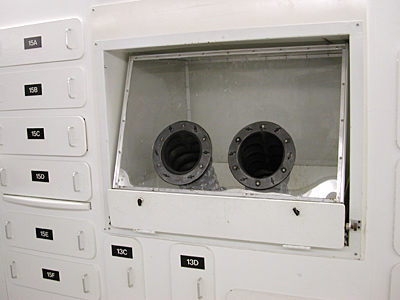
Space station radiation glove compartment
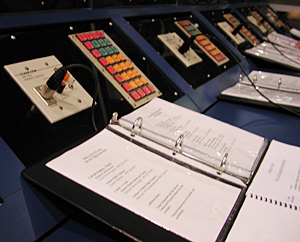
Mission Control notebooks (two for everyone)

Ready to start at Mission Control

The Endeavor simulator
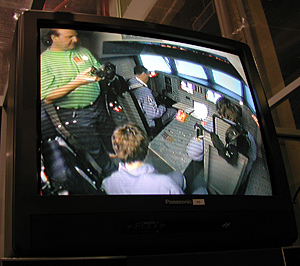
Command cockpit on the Endeavor mission
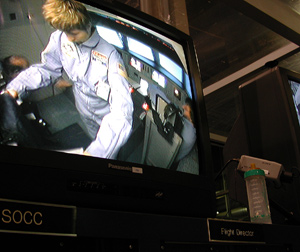
EVA egress as seen from Mission Control
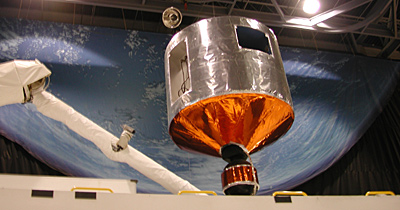
Satellite for practice EVA maneuvers
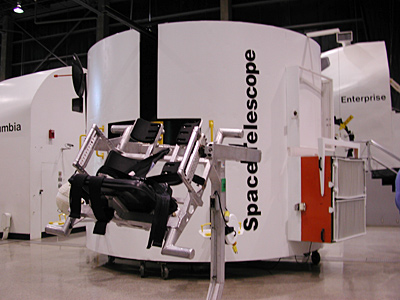
Space telescope and EVA harness

Moments of tension in Mission Control
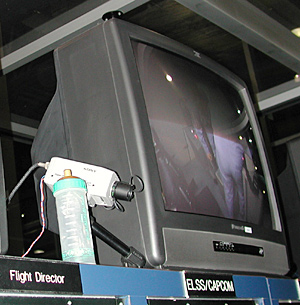
Mission Control camera and bottle (they serve YOUNG scientists!)
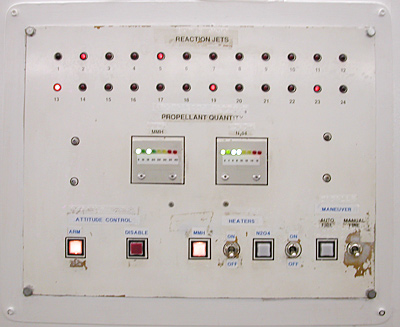
attitude readouts and buttons
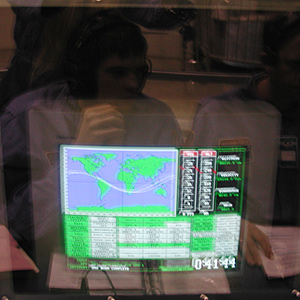
3D artist/Flight Director peers intently at Flight Director screens.
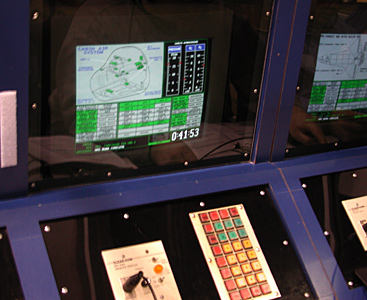
More Mission Control
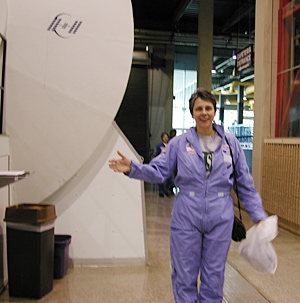
Mission accomplished. Hi Rhonda!